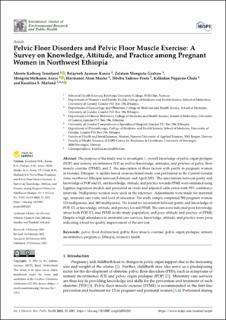| dc.contributor.author | Tennfjord, Merete Kolberg | |
| dc.contributor.author | Ayanaw Kassie, Belayneh | |
| dc.contributor.author | Mengistu Gashaw, Zelalem | |
| dc.contributor.author | Melkamu Asaye, Mengstu | |
| dc.contributor.author | Alem Muche, Haymanot | |
| dc.contributor.author | Tadesse Fenta, Tibebu | |
| dc.contributor.author | Nigussie Chala, Kalkidan | |
| dc.contributor.author | Mæland, Karolina Sofia | |
| dc.date.accessioned | 2023-03-23T11:33:52Z | |
| dc.date.available | 2023-03-23T11:33:52Z | |
| dc.date.created | 2023-02-27T14:44:20Z | |
| dc.date.issued | 2023 | |
| dc.identifier.citation | Tennfjord, M. K., Kassie, B. A., Gashaw, Z. M., Asaye, M. M., Muche, H. A., Fenta, T. T., Chala, K. N., & Mæland, K. S. (2023). Pelvic Floor Disorders and Pelvic Floor Muscle Exercise: A Survey on Knowledge, Attitude, and Practice among Pregnant Women in Northwest Ethiopia. International Journal of Environmental Research and Public Health, 20(5):4201. | en_US |
| dc.identifier.issn | 1661-7827 | |
| dc.identifier.uri | https://hdl.handle.net/11250/3060094 | |
| dc.description.abstract | The purpose of the study was to investigate 1: overall knowledge of pelvic organ prolapse (POP) and urinary incontinence (UI) as well as knowledge, attitudes, and practice of pelvic floor muscle exercise (PFME); and 2: the association of these factors with parity in pregnant women in Gondar, Ethiopia. A facility-based cross-sectional study was performed in the Central Gondar zone, northwest Ethiopia between February and April 2021. The associations between parity and knowledge of POP and UI, and knowledge, attitude, and practice towards PFME were estimated using logistics regression models and presented as crude and adjusted odds ratios with 95% confidence intervals. Nulliparous women were used as the reference. Adjustments were made for maternal age, antenatal care visits, and level of education. The study sample comprised 502 pregnant women: 133 nulliparous, and 369 multiparous. We found no association between parity and knowledge of POP, UI, or knowledge, attitude, and practice toward PFME. The sum score indicated poor knowledge about both POP, UI, and PFME in the study population, and poor attitude and practice of PFME. Despite a high attendance in antenatal care services, knowledge, attitude, and practice were poor, indicating a need for quality improvement of the services. | en_US |
| dc.language.iso | eng | en_US |
| dc.publisher | MDPI | en_US |
| dc.rights | Navngivelse 4.0 Internasjonal | * |
| dc.rights.uri | http://creativecommons.org/licenses/by/4.0/deed.no | * |
| dc.title | Pelvic Floor Disorders and Pelvic Floor Muscle Exercise: A Survey on Knowledge, Attitude, and Practice among Pregnant Women in Northwest Ethiopia | en_US |
| dc.type | Peer reviewed | en_US |
| dc.type | Journal article | en_US |
| dc.description.version | publishedVersion | en_US |
| dc.rights.holder | © 2023 by the authors. | en_US |
| dc.source.volume | 20 | en_US |
| dc.source.journal | International Journal of Environmental Research and Public Health | en_US |
| dc.source.issue | 5 | en_US |
| dc.identifier.doi | 10.3390/ijerph20054201 | |
| dc.identifier.cristin | 2129700 | |
| dc.source.articlenumber | 4201 | en_US |
| cristin.ispublished | true | |
| cristin.fulltext | original | |
| cristin.qualitycode | 1 | |

